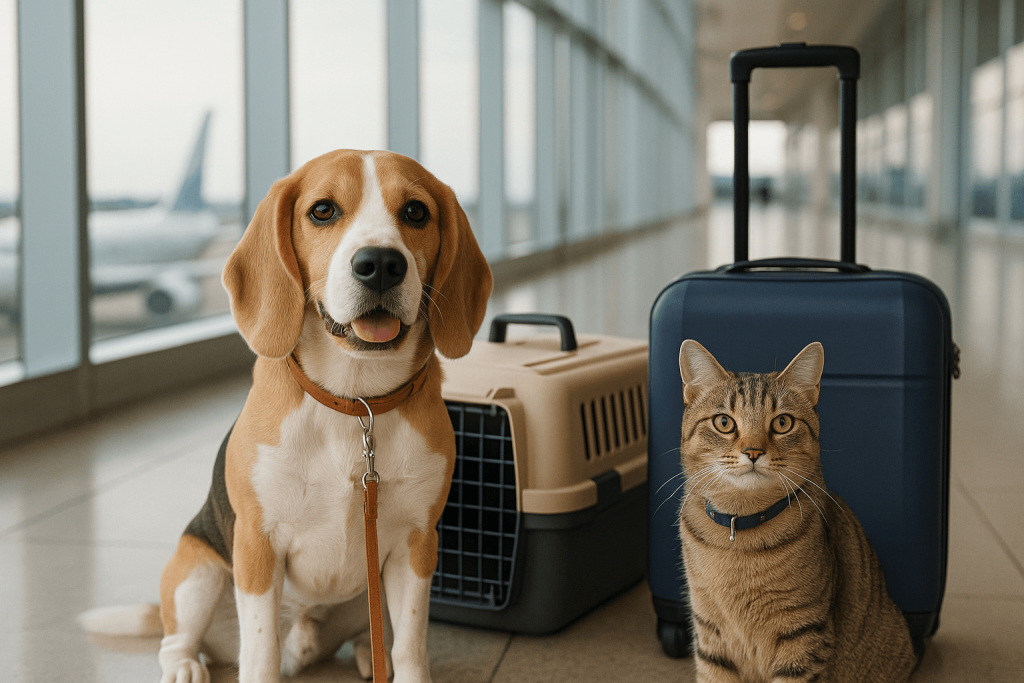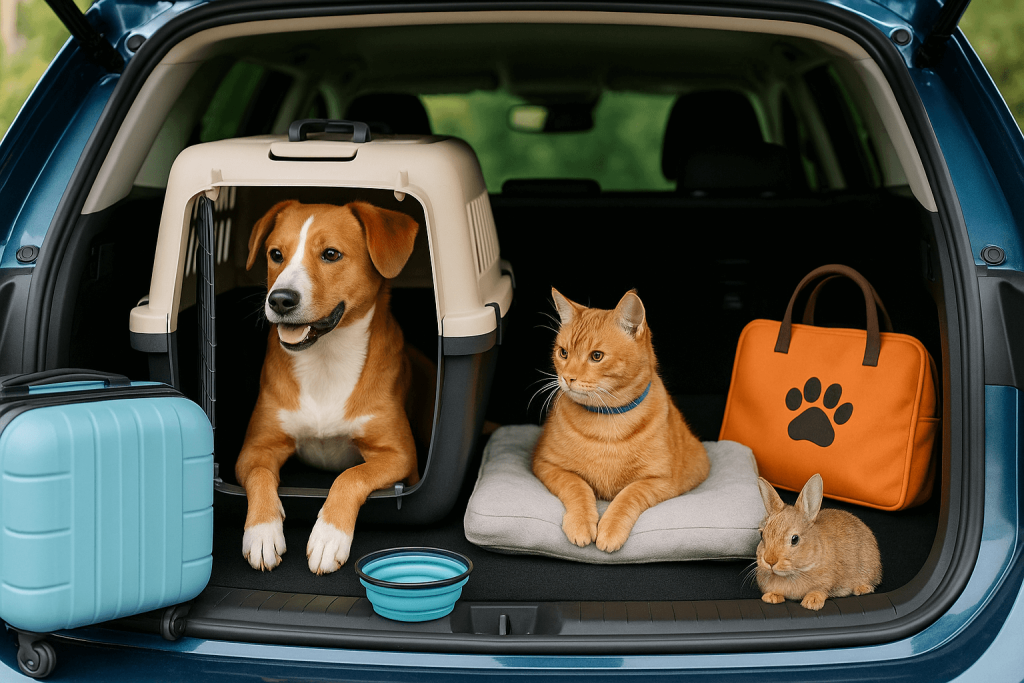Physical Address
304 North Cardinal St.
Dorchester Center, MA 02124
Physical Address
304 North Cardinal St.
Dorchester Center, MA 02124
The Best Pet Destinations
The Best Pet Destinations
Traveling with pets can be one of life’s greatest joys, but it also comes with responsibilities. Whether you’re planning a short road trip, flying across the country, or heading outdoors for an adventure, ensuring pet travel safety should always be a top priority.
A well-prepared journey not only protects your furry friend from stress and accidents but also gives you peace of mind as a pet parent. From carriers and harnesses to hydration and health checks, every detail matters when it comes to safe and comfortable travel.
In this guide, we’ll cover everything you need to know about pet travel safety in 2025—from packing the right essentials to navigating airline policies and keeping your pet calm on the go. By the end, you’ll have a complete checklist to make every trip stress-free and secure for both you and your pet.

Traveling with pets is no longer unusual—millions of families in the U.S. take their furry friends on vacations, road trips, and even international journeys each year. But without the right precautions, even a short trip can become risky. This is where pet travel safety plays a vital role.
Neglecting safety measures can lead to injuries, stress, or even lost pets. For example, unsecured animals in cars are more likely to get hurt in sudden stops or accidents. Similarly, flying without proper preparation can expose pets to dehydration, anxiety, or temperature fluctuations. By focusing on pet travel safety, you’re not just protecting your pet’s health—you’re also ensuring your trip runs smoothly.
The benefits go beyond safety. When you prioritize pet travel safety, you make your pet feel more comfortable, reduce their anxiety, and create a more enjoyable experience for the whole family. It’s about peace of mind, knowing your four-legged companion is secure and cared for every step of the way.
The foundation of pet travel safety begins long before you step into a car, plane, or train. Preparing your pet properly ensures they are healthy, comfortable, and ready for the journey ahead.
Schedule a vet visit a few weeks before traveling. A quick health check ensures your pet is fit to travel, while updated vaccinations protect them from potential risks in new environments. This is a key step in pet travel safety for both domestic and international trips.
If you’re flying, most airlines require a recent health certificate signed by a licensed veterinarian. This document confirms your pet is healthy and safe to travel. Without it, you may face delays or even be denied boarding.
Accidents happen, and pets can get lost in unfamiliar places. A microchip and updated ID tags with your contact information are essential for pet travel safety. These small steps dramatically increase the chances of being reunited with your pet if they wander off.
If your pet has never traveled before, start with short practice trips. A drive around the neighborhood or a visit to a pet-friendly store can help them get used to the carrier, car, or harness. This reduces stress and makes the actual journey smoother.
Packing the right items is just as important as planning your route. A well-prepared travel kit ensures comfort, reduces stress, and keeps your pet safe wherever the journey takes you. Here are the must-have essentials for pet travel safety.
Choose a sturdy, well-ventilated carrier or crate that gives your pet enough room to stand, turn, and lie down. For air travel, make sure it’s IATA-approved. A secure carrier is the cornerstone of pet travel safety during flights and long drives.
Always carry a reliable leash and harness with ID tags attached. Collars can break or slip off, but a harness gives you more control and prevents escapes. This is a simple yet critical part of pet travel safety.
Travel can disrupt your pet’s eating and drinking habits. Carry their regular food in sealed containers, along with collapsible bowls and fresh water. Staying hydrated is essential for pet travel safety, especially on long journeys.
Emergencies can happen anywhere. A pet-specific first aid kit should include bandages, antiseptic wipes, tweezers, and any prescribed medications. Having one on hand provides peace of mind and ensures immediate care if needed.
Travel can be stressful for pets. Bringing along a familiar blanket or toy offers comfort, reduces anxiety, and helps them settle in quickly. While it may seem small, it plays a huge role in overall pet travel safety.

Road trips are one of the most common ways people travel with their pets, but without proper precautions, they can also be risky. These car-specific guidelines will help you prioritize pet travel safety every time you hit the road.
Never let pets roam freely in the car. Use a pet seatbelt harness, booster seat, or secured crate to keep them safe. A restrained pet not only prevents accidents but is also a core principle of pet travel safety.
As tempting as it is to keep your pet in the front seat, airbags can cause serious injuries in the event of an accident. The back seat is the safest place for pets, especially when combined with a carrier or harness. This small adjustment greatly improves pet travel safety.
Pets love sticking their heads out of the window, but it exposes them to dust, debris, and potential injury. Keep windows partially closed or use pet window guards. It’s a simple but essential pet travel safety measure.
On long drives, plan breaks every 2–3 hours. Give your pet a chance to stretch, hydrate, and relieve themselves. This keeps them comfortable and reduces travel stress—both key aspects of pet travel safety.
Flying with pets can feel overwhelming, but with preparation and the right precautions, you can make the experience much smoother. Airlines have strict policies, and understanding them is crucial for pet travel safety.
Every airline has its own set of rules regarding pet travel. Some allow small pets in the cabin, while others require larger animals to travel in cargo. Always check updated guidelines in advance—this step is essential for stress-free pet travel safety.
Get pets travel information for safe journey.
Airlines require IATA-approved carriers that meet specific size and ventilation standards. A well-fitted carrier ensures your pet can move comfortably while staying secure throughout the journey. Picking the right carrier is a foundation of pet travel safety in the air.
Whenever possible, keep your pet in the cabin. If cargo travel is unavoidable, choose nonstop flights, avoid extreme weather, and label the crate clearly. These small details can make a big difference in pet travel safety.
Airports and flights can be stressful environments. Use familiar items like blankets or toys, and ask your vet about calming sprays or natural remedies. Keeping pets relaxed is just as important as physical safety when thinking about pet travel safety.
Not every pet owner chooses cars or planes—sometimes, trains and buses are the best options. While policies vary, a little preparation goes a long way in ensuring pet travel safety during these journeys.
Before booking, check the specific train or bus company’s pet policy. Some allow small pets in carriers, while others have weight restrictions or require advance reservations. Knowing the rules ahead of time is the first step toward pet travel safety.
Just like air travel, a secure carrier is essential. It should be well-ventilated, comfortable, and placed where it won’t block aisles or exits. A stable setup prevents accidents and ensures pet travel safety in shared spaces.
Pack enough food and water for the journey, but avoid feeding your pet right before departure to reduce the risk of nausea. Collapsible bowls are convenient and promote easy hydration—an often-overlooked part of pet travel safety.
Exploring the great outdoors with pets is rewarding, but it comes with unique challenges. Whether you’re hiking, swimming, or camping, following these guidelines ensures your adventures remain fun while prioritizing pet travel safety.
Trails can be unpredictable, so always keep pets on a sturdy leash or harness. Carry enough water, collapsible bowls, and paw protection like booties for rocky or hot surfaces. These steps make hiking safer and improve overall pet travel safety.
Many pets love the water, but swimming isn’t always risk-free. Supervise pets near waves, currents, or deep water, and provide life vests for smaller or less confident swimmers. Shade and hydration breaks are also crucial for pet travel safety under the sun.
Camping introduces pets to new environments, insects, and weather conditions. Keep them secure in a tent or crate at night, use flea/tick prevention, and bring a first aid kit. A well-prepared campsite ensures pet travel safety even in the wilderness.
Even the most loving pet parents can overlook important details when traveling. Avoiding these common mistakes can make a huge difference in maintaining pet travel safety.
Feeding your pet right before leaving can cause nausea or motion sickness. Always feed them a few hours before travel for smoother, safer journeys—an often-forgotten part of pet travel safety.
Unrestrained pets can distract drivers and risk injury in sudden stops or accidents. Using a crate, seatbelt, or harness is a basic but vital rule of pet travel safety.
Traveling abroad requires specific documents like health certificates and vaccination records. Forgetting these can lead to denied boarding or quarantine. Proper paperwork is a key element of pet travel safety.
Pets are sensitive to extreme heat or cold. Leaving them in cars, exposing them to hot pavements, or ignoring cold-weather gear are common mistakes that compromise pet travel safety.
Traveling with pets doesn’t have to be stressful—for you or your furry friend. With the right preparation and mindset, you can make every trip smoother while keeping pet travel safety at the forefront.
Natural calming sprays, pheromone diffusers, or vet-approved travel treats can help reduce anxiety. Keeping pets relaxed is just as important as physical safety when it comes to pet travel safety.
Not all hotels or rentals welcome pets. Always confirm in advance to avoid last-minute surprises. Pet-friendly lodging ensures comfort while maintaining consistent routines that support pet travel safety.
Pets thrive on routine. Try to feed them at the same times you would at home. This prevents digestive upset and adds familiarity to new environments—an underrated part of pet travel safety.
Always know the location of nearby vets and animal hospitals at your destination. Carry an emergency contact card and keep your pet’s medical records handy. Being ready for the unexpected is a cornerstone of pet travel safety.
Traveling with pets can be one of the most rewarding experiences, but it requires thoughtful planning and preparation. By focusing on pet travel safety, you protect your furry friend from unnecessary stress, health risks, and accidents while ensuring every trip is enjoyable for the whole family.
From pre-travel vet visits and packing essentials to securing pets in vehicles and understanding airline policies, each step plays a vital role in keeping your companion safe. Outdoor adventures, car rides, or international flights all become smoother when pet travel safety is made a top priority.
👉 Before your next journey, bookmark this guide and keep it handy. At pawsontheway.info, you’ll have everything you need to make travel stress-free, secure, and fun for both you and your pet..